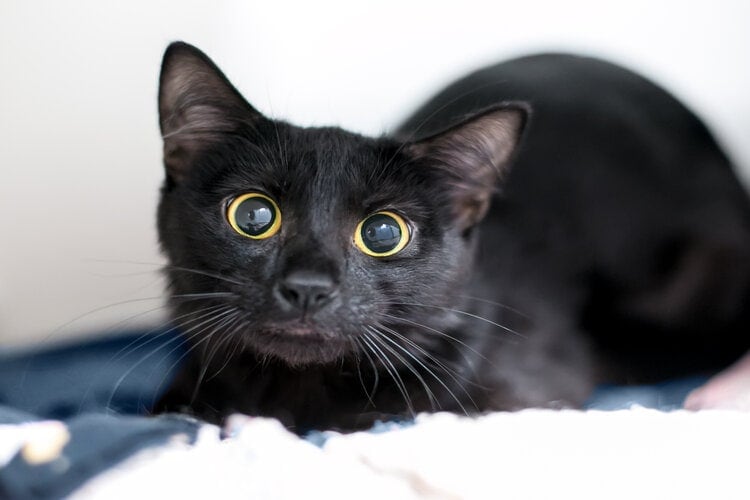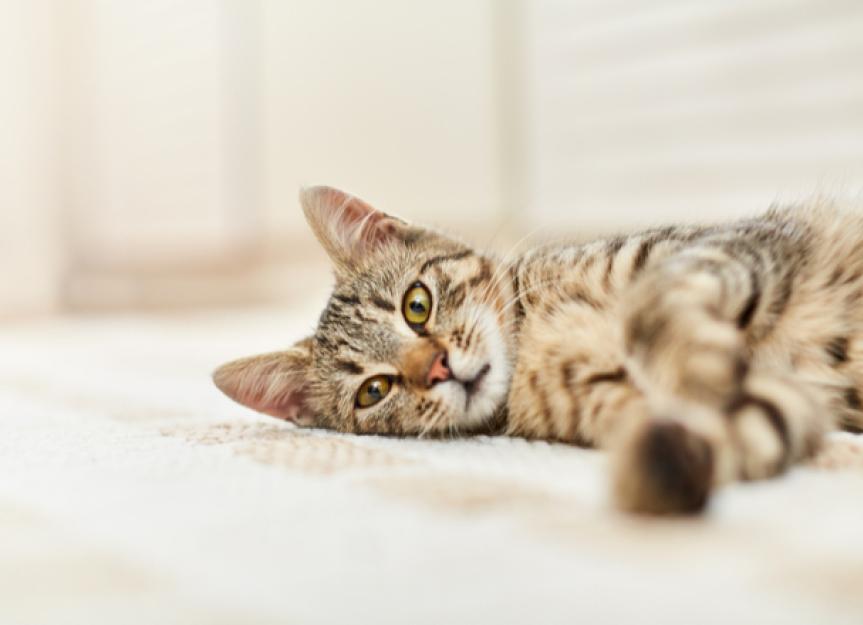Strokes in cats are caused by a lack of blood supply to parts of the brain or bleeding within the brain. Strokes and other abnormal neurological events can cause loss of certain functions such as balance, equilibrium, limb control, vision, and consciousness. The immediate onset of stroke symptoms may also indicate vestibular syndrome, seizures, or another problem. Whatever the reason, if symptoms suggest a stroke, a cat needs to be taken to the vet immediately to find the cause of the stroke and for proper care.
Table of Contents
Recognize symptoms of a stroke in cats
Check the cat’s general alertness.
If your cat behaves abnormally, you must evaluate its overall health. If the cat has lost consciousness, you need to check its breathing. Check to see if the cat responds to the sound of your voice. Watch for tremors or spasms.
Watch for signs of depression.
A cat that has had a stroke may exhibit symptoms that we humans typically refer to as depression. The cat may appear unusually calm and not respond in a usual way.
- This behavior could occur because the cat feels disoriented, dizzy, nauseous, and has a pounding headache.
Watch for any abnormal head tilt.
You may notice the cat holding its head at a strange angle so that one ear is under the other. This symptom could include tilting, turning, or twisting of the head. In the case of a stroke, this symptom indicates pressure in a specific part of the brain.
- This symptom may also indicate another problem, such as vestibular syndrome. This damages the vestibular system in the cat’s inner ear. Vestibular syndrome affects the cat’s sense of balance and orientation similarly to a stroke. This symptom must be addressed first. Take your cat to the vet, whether the cause is a stroke or vestibular syndrome.

Pay attention to a wobbly gait and turning movements.
You may notice that your cat cannot walk in a straight line. The kitty may stagger as if drunk, fall on its side, or walk in circles. If the cause is a stroke, this symptom is also triggered by pressure on a specific part of the brain.
- These symptoms can also manifest as weakness or poor posture on one side of the body. The kitty may misjudge steps or show signs of weakness in all legs.
- Like other symptoms caused by pressure on the brain, unsteady gait and/or circling movements can also be a sign of vestibular syndrome.
- If your cat has tremors or moves its limbs wildly and rhythmically, this may indicate a seizure. In some cases, you may not be able to see the actual seizures. You may then find the disoriented cat. This is called the postictal phase of the seizure and can last from a few minutes to a few hours. An isolated seizure is not critical, but you should still take the cat to the vet as quickly as possible.
Examine the cat’s eyes.
Look closely at your cat’s eyes. If she had a stroke, the pupils might be different sizes, or the eyes might dart back and forth. This is called nystagmus and is caused by a lack of blood supply to the nerves leading to the eyes.
- The third eyelid will stand out if your cat’s pupils are different sizes. If the head is tilted, this indicates vestibular syndrome rather than a stroke.
- As a side effect of nystagmus, your cat may feel sick due to motion sickness.

Check whether your cat can no longer see anything.
Although it is less common than the other symptoms of a stroke, some cats can become blind from a stroke. Even if a stroke does not cause blindness, it is a suspicious sign of high blood pressure in a cat, which often precedes a stroke.
Look at your cat’s tongue.
It should be pink. It is serious if the tongue is blue, purple, or white. It would be best to take your cat to a veterinary clinic immediately.
Source: Cat in a Flat
Don’t look too closely at stroke symptoms that people exhibit.
The most classic signs of a stroke in humans include partial paralysis and drooping of one side of the face. Strokes in cats are not the same as in humans. These symptoms are not typically seen in a cat.
Pay attention to how quickly the symptoms appear.
Because the blood supply to the brain stops very quickly, the consequences of the stroke appear very suddenly. For example, if your cat is having increasing problems with balance over weeks, it’s probably not due to a stroke. However, you should still take your cat to the vet if symptoms recur or worsen.
Observe how long the symptoms last.
In a cat, the symptoms of a stroke last at least 24 hours. If you notice symptoms, you should take your cat to the vet immediately, but this is not always possible. Cats can have a mini-stroke or a transient ischemic attack (TIA) like humans. This means that the symptoms will subside after a day. However, you should still take your cat to the vet even if the symptoms become less severe.
- These short-term signs indicate that your kitty may have had a stroke that needs to be treated medically to prevent the cat from having a full-blown stroke in the future.
Consider your cat’s medical history.
While it’s not a direct, observable sign, cats with underlying health problems are more likely to have a stroke. If you visit the vet regularly, look at your cat’s records. If the vet has previously diagnosed your cat with kidney disease, heart disease, high blood pressure, or an overactive thyroid, the chances of a stroke are much higher.

Caring for a cat that had a stroke
Take the cat to the vet immediately.
The sooner the cat gets to the vet, the better care it will receive and the better chance of recovery. Strokes in cats do not always have as drastic effects as in humans. But you must take him seriously and take care of the cat immediately.
- When you put the cat in the carrier, call your veterinarian and tell him about the symptoms you noticed.
- You may need to take her to a veterinary hospital emergency room if it’s late.
Work with the vet.
The vet will ask you a few questions to help determine the subsequent treatment. He will ask many questions about your cat’s behavior, so pay close attention to him. He will ask if your cat may have ingested something, such as a plant, medication, or poison, that could have caused the symptoms. He will also ask if there was any trauma, such as a fall, before the symptoms. He will want to know if anything has changed with fluid and food intake. He will also ask about vomiting, diarrhea, and general lethargy.
- You need to know if your cat has recently received its rabies vaccination.
- Get tests done.
- Your veterinarian may perform a blood test, urinalysis, x-ray, or ultrasound to diagnose a stroke or underlying medical conditions often accompanying cat strokes. If your veterinarian thinks there may be a serious neurological problem, you may need to consult a veterinarian specializing in neurology. The specialist might do further tests, such as an MRI or CT scan, to determine a blood clot or the area of damage in the brain. These tests are performed on animals in a similar way to humans.
Take care of your cat.
Your cat’s symptoms will often disappear after a few days of home care. Sometimes, the cat may need to stay at the vet for a while. The neurological consequences are difficult to predict. You and your veterinarian will need time to determine the long-term effects or illnesses.
- If your cat has motion sickness as a symptom, it can be treated with medication such as Cerenia.
- If your cat doesn’t have an appetite, it can be stimulated with mirtazapine.
- If your cat is having seizures, your veterinarian will likely recommend treatment with anti-seizure medications such as phenobarbital.

Find out about possible consequences.
If the symptoms were indeed from vestibular syndrome, your cat could recover spontaneously in a few days. In other cases, your cat’s head may remain crooked. This could be a long-term consequence while she is otherwise feeling well. Other cats continue to have balance problems. Because the brain is so complicated, the consequences of a neurological event cannot be wholly predicted.
- It can be hard to see your cat staggering around. But do not worry. She’s probably not in pain.
Protect your cat.
Any cat with neurological problems should remain indoors for their safety. You may need to keep the cat in a room when he comes home for a while. This is for their safety, especially if you have other pets that might attack the cat because of its abnormal behavior.
Help your cat eat and perform other bodily functions if necessary.
During recovery, you may need to help your cat eat, drink, and use the litter box. This depends on the severity of their condition. You may need to pick her up and carry her to the food bowl, water bowl, or litter box. Watch for signs that she is hungry or needs to go to the litter box. This includes meowing and general discomfort.
- It takes time to know whether this is only necessary short-term or long term.
Be careful when children are around the cat.
While you observe the cat and look for symptoms, you need to be careful around children. If your cat is confused, disoriented, or has had a seizure, he may bite or scratch unintentionally. Keeping children away from her is the best way to avoid injuries.
Be patient.
With proper care, some cats recover very quickly. But even in these cases, recovery can take two to four months. During this time, be patient and remember how much your cat needs you during this time.
Tips
- If you don’t know exactly what’s happening with your cat, always contact a veterinarian.
- While these symptoms are not all related to a stroke, it is essential to see your cat to the vet if he exhibits any of the following signs: loss of consciousness, seizures, circling movements, a sudden inability to use his hind legs, a tilted head, fast-moving movements Eyes, loss of balance, inability to stand or walk without falling over, uncoordinated walking, sudden blindness, sudden deafness, unfocused or confused staring into the distance, standing in one place staring at the wall or pressing your face against a surface for minutes.
FAQs
Q: What are the signs and symptoms of stroke in cats?
A: The signs of stroke in cats may include sudden loss of balance, inability to walk correctly, confusion, head tilting, and difficulty controlling movements.
Q: How is a stroke in a cat diagnosed?
A: A stroke in a cat can be diagnosed through clinical signs, neurological examination, and, in some cases, imaging tests such as MRI to evaluate the brain for stroke-related changes.
Q: Can cats recover from a stroke?
A: Many cats can recover from a stroke with appropriate medical care and treatment. The prognosis for recovery depends on the severity of the stroke and any underlying health conditions.
Q: What are the treatment options for cats with a stroke?
A: Treatment for cats that have had a stroke may include supportive care, medication to manage symptoms, and addressing any underlying health issues such as high blood pressure or hyperthyroidism.
Q: When should I seek emergency veterinary care if I suspect my cat may be having a stroke?
A: If you suspect your cat may be having a stroke, it is essential to seek emergency veterinary care immediately. Time is critical in the management of stroke in cats.
Q: What is the underlying cause of stroke in cats?
A: The underlying causes of stroke in cats can include blood vessel abnormalities, high blood pressure, kidney disease, heart disease, and underlying conditions such as hyperthyroidism.
Q: Can cats experience a full recovery after a stroke?
A: Some cats may experience a full recovery after a stroke, especially with prompt diagnosis and appropriate medical management. However, the extent of recovery varies from cat to cat.
Q: Should treatment continue after a cat has experienced a stroke?
A: Yes, ongoing treatment and management may be necessary to address any lingering effects of the stroke and to prevent future occurrences, especially if the underlying cause is a chronic condition.
Q: How can I tell if my cat is having a stroke?
A: If you notice sudden changes in your cat’s behavior, such as loss of coordination, disorientation, or difficulty controlling movements, contact your vet immediately for evaluation.
Q: Are strokes in cats similar to strokes in dogs and humans?
A: Strokes in cats share some similarities with strokes in dogs and humans, but there are also notable differences in underlying causes, symptoms, and prognosis. Consulting a veterinary neurologist can provide more specific insights.